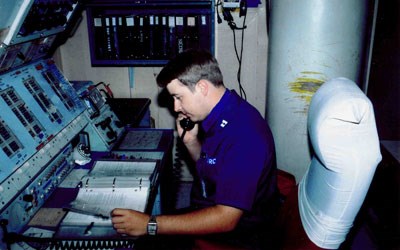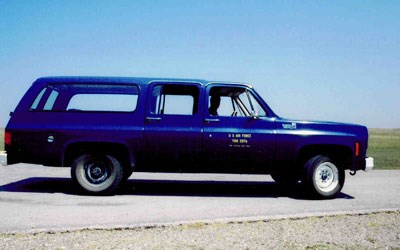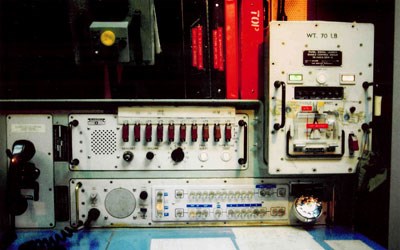Last updated: October 20, 2020
Article
Behind Blast Doors

NPS/Mark Wilderman (MIMI 2363-48)
A Day in the Life of a Missile Combat Crew
Visitors who take the ranger-guided tour of the Delta-01 launch control facility spend only thirty minutes inside the structure, and merely get a taste for the strange mixture of routine and monotony that made up the life of a missile combat crew member during the Cold War. In a four-year tour, a missile officer would serve approximately 300 alerts in an underground control center. Missile crew duty required a great amount of inner strength and quiet dedication to accomplish a tremendously important, but largely thankless, task. This recounting of a twenty-four hour alert at Delta-01 by Major Mark Wilderman, USAF (retired) provides valuable insight into the routine of an Air Force missileer at the height of the Cold War.
NPS/Mark Wilderman (MIMI 2363-81)
A Typical 24-Hour Alert at Delta One
Vehicle Barn (0630)
The Deputy Commander was responsible for visiting the Vehicle Barn around 6:30 a.m. to sign out and inspect the crew vehicle (usually a Chevrolet Suburban or a lightweight Ford station Wagon). From October 1st until May 1st, each vehicle was required to have a footlocker-sized survival kit on board (full of blankets, candles, etc.) in case of a vehicle breakdown in winter weather. All crew vehicles were equipped with Motorola radios for emergencies or to make periodic security checks when transporting critical components to the missile field. The two man crew met at the squadron office.
Pre-Departure (0700)
At 0700 sharp. The Pre-Departure Briefing was held in the briefing room, attended by all 15 missile crews, squadron commanders, and briefers from the Weather Squadron. Crews were briefed on world events, weather, and anything else relevant to the mission. The Commander was issued his code pages for the day, along with any classified material that needed to be transported to the field. Crews usually departed Ellsworth on 1-90 around 7:30 a.m.
Breakfast/Safety Stop at Wall Drug (0830)
Your first stop after departing the base was either the Mini Mart outside the Main Gate or Wall Drug for coffee and breakfast. We avoided Wall Drug during the height of the tourist season, due to the crowds, and were not allowed to stop anywhere when armed and couriering launch panels or sealed authenticator documents to the missile field.
Arrival at Delta-01 (0930)
We usually arrived at the LCF around 9:30 a.m. for changeover. Some crewmembers got to the LCF even earlier, because they were addicted to their favorite soap operas (this, in an era of all-male crews)! After an informal status briefing from the Facility Manager, the Commander authenticated to the on-duty capsule crew using the phone in the FSC's office. After the capsule crew buzzed the access door to the elevator room, we loaded our crew bags, and parkas into the elevator. We rode the elevator 31 feet down to the tunnel and waited for the "stand clear!" shout from the on-duty deputy.
Crew Changeover (1000)
Once inside the control center, we traded rumors with the on-duty crew before receiving a status briefing. At the appropriate point on the crew changeover checklist, the on-duty crew's locks came off the red box and the documents and launch keys were carefully inventoried, launch and enable panel switches were checked. After everything in the LCC was determined to be in proper order, the new crew received the two Smith & Wesson .38 pistols from the old crew. The new crew then signed the crew log, accepting custody of ten mated reentry vehicles, the tworevolvers, and ammunition.
The Commander called the Wing Command Post to accept the alert. Most often, the old crew had to wait for the ECHO crew to stop by and pick them up for the trip back to Ellsworth.
LCC Inspections (1100)
Once the blast door was closed, the new crew changed into more comfortable clothes. Most crews wore sweat pants, sneakers, and a sweat shirt. Next, the Commander and Deputy ran their respective Inspection Checklists. Around 1100, the crew ordered lunch (foil packs and an occasional fresh salad).
Remote Weather (1500)
Around 1500, SAC Global Weather at Offutt AFB transmitted the daily weather for each sortie and each target slot. The purpose of the daily weather was to make the Minuteman II ICBM more accurate by adjusting for the wind and atmospheric pressure over the targets on the other side of the globe. In the late afternoon, after the correct targets and weather had been verified and all LF maintenance had ended, the crew settled down to TV viewing on the tiny Sony color TV.
Dinner (1700)
The crew could order more delicious foil packs and a salad for dinner at 5:00 p.m.
Filling Time
Both crewmembers were required to be awake to decode incoming EAMs. From sunup, we monitored UHF Channel 1 and after sundown, we monitored UHF Channel 6 for helicopters. The two security crews topside changed shifts at approximately 6:00 p.m. and 6:00 a.m. Diversions during your crew partner's sleep shift included watching the three TV stations from Rapid City, AM/FM radio, HF radio, or reading magazines, novels, working on Master's courses, and cleaning control center.
Sleeping in Shifts (1900 & 0300)
The DMCCC slept from 1900-0300 and the MCCC slept from 0300-0900.
Relief Arrives (0930)
Around 0930, the entire process began again with the arrival of the relief crew.
Return to Ellsworth AFB (1130)
By 11:30 a.m., the crew was back at Ellsworth. On rare occasions, crews were transported to the missile sites via UH-IF "Huey" helicopters.

NPS/Mark Wilderman (MIMI 2363-27)
Learn More
The following books also provide useful background:A visit to Minuteman Missile National Historic Site and a tour through the Delta-01 launch control facility allows for a unique opportunity to learn more about the secret world of nuclear weapons.
Heffner, Gretchen. The Missile Next Door: The Minuteman in the American Heartland. Harvard University Press, 2012.
Engel, Jeffery et. al. The Missile Plains: Frontline of America's Cold War. Historic Resource Study, Minuteman Missile National Historic Site. Omaha, Nebraska: National Park Service, Midwest Regional Office, 2003.
